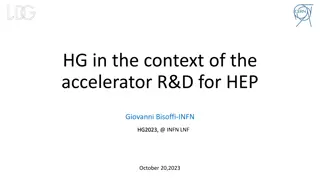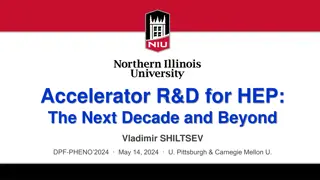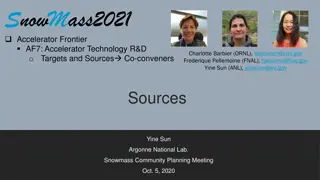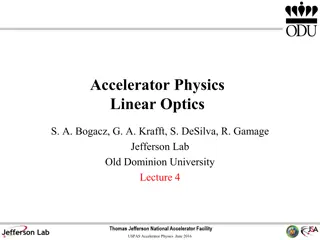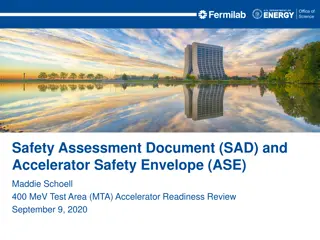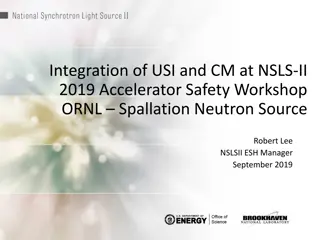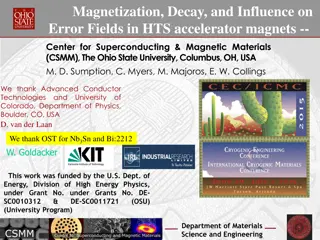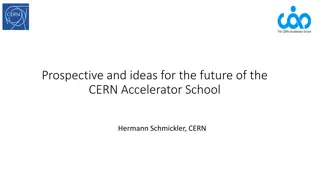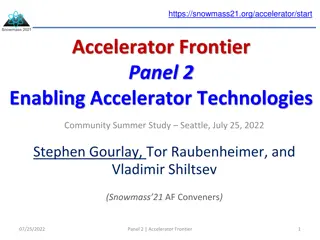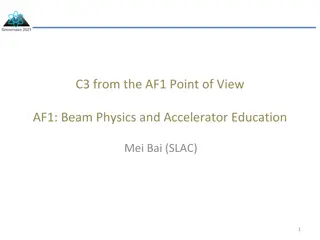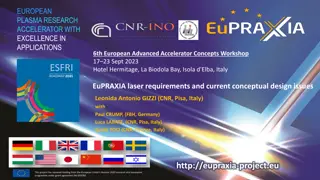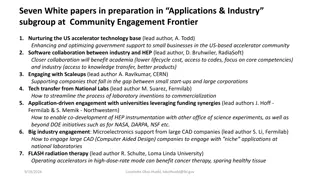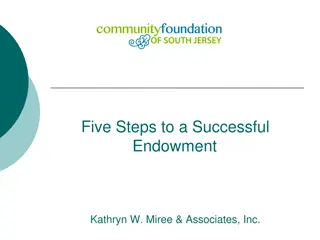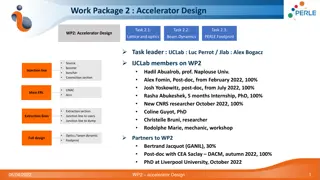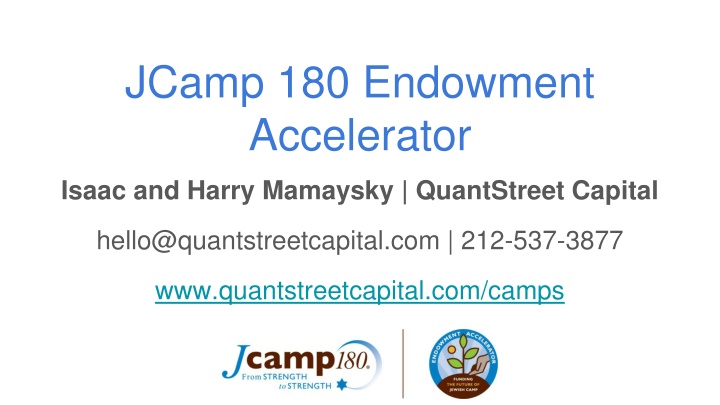
Endowment Management: Legal Considerations, Governance, and UPMIFA
Explore the legal considerations, governance aspects, and UPMIFA principles related to endowment management in nonprofit organizations. Learn about the Uniform Prudent Management of Institutional Funds Act (UPMIFA) and essential definitions of endowment and institutional fund.
Download Presentation

Please find below an Image/Link to download the presentation.
The content on the website is provided AS IS for your information and personal use only. It may not be sold, licensed, or shared on other websites without obtaining consent from the author. If you encounter any issues during the download, it is possible that the publisher has removed the file from their server.
You are allowed to download the files provided on this website for personal or commercial use, subject to the condition that they are used lawfully. All files are the property of their respective owners.
The content on the website is provided AS IS for your information and personal use only. It may not be sold, licensed, or shared on other websites without obtaining consent from the author.
E N D
Presentation Transcript
JCamp 180 Endowment Accelerator Isaac and Harry Mamaysky | QuantStreet Capital hello@quantstreetcapital.com | 212-537-3877 www.quantstreetcapital.com/camps
Receive insights & analysis from QuantStreet: bit.ly/quantstreet
Overview Legal considerations and governance JCamp gift requirements and policies Implementation Investment plan Spending plan Additional considerations Selecting the right advisor What if you re from Canada You can find more information at: JCamp 180 s Endowment Accelerator Website JCamp s Endowment Accelerator Toolkit 3
Legal Considerations and Governance For a detailed exploration of governance and policy considerations, please read: bit.ly/endowmentarticle 4
Uniform Prudent Management of Institutional Funds Act When a nonprofit organization establishes an endowment or institutional fund, the organization s management and investment obligations are governed by applicable state law. While endowment laws vary among states, they share many common features thanks to the Uniform Prudent Management of Institutional Funds Act ( Model Law or UPMIFA ). The Model Law thus provides a useful overview of the national landscape of endowment and institutional fund governance. However, each state s lawmakers decide whether to adopt UPMIFA in whole or in part and whether to modify its language. The Model Law also contains optional provisions, which some states adopt while other do not. This makes it important for nonprofits to base their endowment and institutional fund policies on their actual state law, rather than the Model Law. 5
UPMIFA Core Principles Under the Model Law, endowment and institutional fund management is based on two core principles: first, assets should be invested prudently in diversified investments that seek growth and income; and second, once assets appreciate, the appreciation can be prudently spent for the endowment s purposes. 6
Definitions Endowment Fund: The Model Law defines an endowment fund as an institutional fund or part thereof that, under the terms of a gift instrument, is not wholly expendable by the institution on a current basis. In plain English, this means that an endowment results from a restricted donation that is conditioned on the organization investing the principal and benefiting from its income, rather than spending the principal for immediate needs Institutional Fund: On the other hand, when a nonprofit designates surplus revenue as investment assets, the resulting institutional fund (often called a quasi endowment or board-designated endowment ) is not subject to the Model Law s protections of investment principal. Unlike an endowment, an institutional fund is unrestricted, in the sense that no donor has limited how it can be used. Unlike the principal of an endowment fund, the principal of an institutional fund may be spent as needed by the organization. 7
1. Standard of Conduct for Managing & Investing Institutional Funds UPMIFA requires that decision-makers give primary consideration to the donor intent expressed in the gift instrument, followed by consideration of the charitable purposes of the organization and the specific objectives of the institutional fund. The Model Law also requires decision-makers to act in accordance with a number of fiduciary duties: (1) they must exercise the duty of care and act with good faith when performing investment and management activities; (2) they have a duty to minimize investment costs and authorize only those costs that are appropriate and reasonable; (3) they must investigate the information used when making investment decisions and managing the fund; and (4) they must act in accordance with the duty of loyalty, which requires managing and investing the assets solely in the best interests of the organization. 8
2. Standard of Conduct for Managing & Investing Institutional Funds When managing and investing an institutional fund, decision-makers should consider the following factors: general economic conditions; effects of inflation and deflation; tax consequences, if any, of investment decisions; the role of each investment in the overall portfolio; the expected total return from income and appreciation of the assets; other resources of the organization; the needs of the organization and fund to make distributions and preserve capital; and an asset s special relationship or value, if any, to the charitable purposes of the organization. Decisions regarding individual assets cannot be made in isolation; rather, they should be made in light of the entire portfolio and overall investment strategy, which should have risk and return objectives that are suited to the fund and organization. 9
3. Standard of Conduct for Managing & Investing Institutional Funds The Model Law allows fund assets to be invested in any kind of property or type of investment, subject to donor restrictions (such as not investing in tobacco products, to use an example from the comments). Assets must also be diversified, unless special circumstances dictate otherwise. And new assets must be reviewed within a reasonable time after they are donated to ensure they conform to the investment strategy and objectives of the fund. 10
Expenditure and Accumulation of Endowment Funds The Model Law sets forth a seven factor prudence test to make accumulation and spending decisions for endowments: (1) the duration and preservation of the endowment fund; (2) the purposes of the institution and the endowment fund; (3) general economic conditions; (4) the possible effect of inflation or deflation; (5) the expected total return from income and the appreciation of investments; (6) other resources of the institution; and (7) the investment policy of the institution. Note that this Seven Factor Prudence Test is subject to any applicable donor restrictions. Some states adopt a presumption of imprudence if an endowment spends more than 7% of its 11 principal in one year. However, this does not suggest that any spending below 7% is prudent.
Protection of Principal The Model Law imposes specific rules of construction on terms like income and endowment. The assumption . . . is that a donor who uses one of these terms intends to create a fund that will generate sufficient gains to be able to make ongoing distributions from the fund while at the same time preserving the purchasing power of the fund. As time goes by, some appreciated value of the principal must be preserved to maintain the spending power of the original gift. The old version of UPMIFA included a rule that prohibited spending an endowment fund below its historic dollar value. Among other issues, historic dollar value no longer represents the original purchasing power of the gift as time goes by. UPMIFA assumes that donors intend to preserve the purchasing power of their gift. To the extent a fund has appreciated, some of the appreciation should be retained to preserve 12 purchasing power.
Delegation of Management and Investing The Model Law allows organizational decision-makers to delegate fund management and investing to third party managers. In choosing a manager, decision-makers must act in good faith and use reasonable skill, care, and caution while ensuring that the manager s fees are reasonable. They must also define the scope of the investment manager s work in light of the purposes of the institutional fund, and they must periodically review the manager s actions to monitor performance and ensure compliance with the scope of delegation. Notably, the Model Law only allows management and investment functions to be delegated: decision-makers cannot delegate the authority to make decisions concerning expenditures... 13
Release and Modification of Donor Restrictions The Model Law gives significant deference to donor restrictions but also recognizes that restrictions may become impracticable, wasteful, or an impediment to fund management over time. When this happens, a donor may simply consent to release the restriction assuming the donor is alive and has capacity to do so. When this is not possible, the Model Law provides a mechanism for organizations to seek court approval to modify restrictions in accordance with the donor s probable intent. The Model Law also allows organizations to modify restrictions on small and old funds without going to court. If a fund contains less $25,000 and is more than 20 years old, then the organization may notify the attorney general of its planned modification, and if there is no objection within 60 days, modify the restriction in light of the charitable purposes expressed when the original gift was made. 14
JCamp Gift Restrictions/Requirements The Endowment Accelerator Grant is a restricted gift. It requires that your endowment has the following characteristics: The endowment must be for the sole benefit of the camp. The endowment must be invested through an organization such as a brokerage firm, a financial institution, or a community endowment fund. Individual investment agents or self-managed endowments are not eligible for the Endowment Accelerator Matching Grant. You also need to have approved policy documents (discussed below). jcamp180.org/grants/endowment-accelerator/endowment-accelerator-2024/guidelines 15
Potential Custodians Once you establish an endowment, you will need to decide where to keep the funds. JCamp wants to ensure that you set up your fund with a reputable financial institution. JCamp provides the following guidance about choosing a custodian, which gives you a few options: Explore whether your fund can be held and managed by a local Jewish federation or with a secular community foundation. Ask what kinds of investment vehicles and management services your bank offers. Consider working with an advisor at a local investment firm or a national firm such as Vanguard or Fidelity. jcamp180.org/professional-development/endowment-accelerator/endowment-accelerator-toolkit ( Step Two: Establishing Your Permanent Endowment Fund ) 16
JCamp Required Policies Endowment policy documents must be approved by your camp s governing body and contain the following elements to be eligible for the Endowment Accelerator Matching Grant. A spending policy, that includes: how the annual distributions are to be calculated; allowed usages of the annual distributions; a statement protecting the fund principal from use other than in extraordinary circumstances, which must be clearly defined; and a successor plan, detailing what happens to the fund if the camp ceases to exist. An investment policy for the endowment fund is to be invested; and Gift acceptance policies outlining how gifts are to be accepted and invested. See these and other important JCamp policies at https://jcamp180.org/grants/endowment- 17 accelerator/endowment-accelerator-2024.
Investing Plan Over time, endowment growth will come from two sources: Investment returns and income Additional gifts As the plan overseer, you need to determine a prudent investment plan Based on JCamp 180 guidance, a reasonable range for allocations is Baseline Range Investment Vehicles Equity not single stocks Fixed Income ETFs Cash-like Source: JCamp180 Endowment Accelerator Toolkit 60% 50-70% Mutual funds, ETFs, 35% 25-45% U.S. Treasuries, mutual funds, 5% 19 Bank deposits, CDs, money-markets,
Realized Returns According to JCamp180, a 60/35/5 allocation yielded 7% per year on average According to BlackRock, their 60/40 Target Allocation Fund had the following returns as of January 2024 1 year 3 year 5 year 10 year 15.68% Average return 6.45% 2.73% 9.01% Our work at QuantStreet shows that 60/40 portfolio can experience very negative returns in some years (e.g., -20% or worse) Bad endowment return years can be associated with increased gifting* Through June of 2022, the average last-12-month university endowment return was -8% But the change in total endowment size was only -4% The difference comes from a +22% increase in gifts received relative to 2021 Your spending policy should account for the potential of bad return years 20 *Source: 2022 NACUBO-TIAA Study of Endowments
Spending Plan JCamp180 suggests a distribution rate of 4-5% per year from the endowment This percentage can be applied to either the average market value of the endowment over the prior 4 quarters or over the prior 3 years This is consistent with the range of expenditures reported by university endowments There is potentially a carveout for larger expenditure for unforeseen events Endowment distributions are typically meant for recurring expenses: Scholarships Staff salaries Minor capital improvements Special programs and trips Core Principle After planned spending (around 4%) and fees (around 1%), the rest of the endowment should grow at least at the rate of inflation (around 2%). The end goal is to have spending grow at the rate of inflation over time 21
An Example of an Investment and Saving Plan The endowment starts off here Example of expected distribution and growth from $5mm fund This assumes the average return happens (more on this below) Returns are allocated between spending, fees, and growth. The distribution can come partially from asset sales. The endowment grows by $100k, assuming no gifts This analysis does not account for new gifts Add that distribution can come from income or sale of securities The endowment amount will likely grow more than this due to gift inflows The power of compounding over 20 years! Source: JCamp180 Endowment Accelerator Toolkit 23
Endowment Growth and Distributions Over Time Under these assumptions the endowment will grow to 7.43mm after 20 years If inflation runs at its historical rate, this will just keep up with inflation Assumes no new gifts This analysis ignores what happens when there is uncertainty Endowment grows at 7% per year, with a 5% spend rate Initial endowment start at 5mm 24
Endowment Growth and Distributions Over Time This emphasizes the needs to: (1)Dynamically adjust spending policies in response to market conditions; (2)Ensure that your endowment s risk level is appropriate for your organization. This analysis allows for the growth rates to change over time. The blue line represents a good set of market outcomes. Initial endowment start at 5mm But some outcomes can be much worse. 25
Additional Considerations What is your organizational risk tolerance? Can organization survive a lower spend from the endowment for a few years? How much will your donors support the endowment in down market years? Diversification and liquidity Your portfolio should not have large exposures to single-name securities or other sources of idiosyncratic risk (which should be diversified away at the portfolio level) Many investment look good on paper, but are highly illiquid, meaning that you may not be able to get your money out then you need to Fees associated with underlying investment vehicles The mutual funds and ETFs in your endowment portfolio will charge fees Is your endowment avoiding high-fee mutual funds, ETFs, and other managed products? For example, there are two large, liquid Emerging Markets (China, India, Korea, Taiwan, etc.) ETFs: EEM charges 0.70% annual fee while VWO charges 0.08% 27
Choosing a Financial Advisor JCamp180 requires that the endowment be custodied at a major national broker or investment manager You may consider also hiring a financial advisor Refer to JCamp 180 guidance under Step Two from this page A financial advisor should help you think through all aspects of the investing and spending policy How should assets be invested? How much risk to take? What is a reasonable distribution rate in light of the endowment s investments? How should the endowment respond to changing market conditions? The advisor should work with your endowment committee, and with senior leadership, to ensure the camp s endowment is appropriately invested A typical financial advisor fee for endowments is 1%* 28 *Source: 2022 NACUBO-TIAA Study of Endowments.
Final notes Additional Coaching Camps can receive up to 2 hours additional coaching from us If you are interested, please reach out to either Isaac or Harry Taxes We are not tax experts, though it is our understanding that income generated by a camp endowment is not taxed For tax questions, please contact your accountant Canada Most of presentation is from the point of view of a U.S. camp In Canada, tax laws and market structure differ Please contact JCamp180 for information about Canadian endowments 29
Receive insights & analysis from QuantStreet: bit.ly/quantstreet Our contact information: 212-537-3877 imamaysky@quantstreetcapital.com hmamaysky@quantstreetcapital.com
Whats Next? Sign up for Coaching Endowment Policies - due to JCamp 180 on 10/31/24 through the grants portal Upcoming Endowment Webinars 31
Types of Investment Vehicles Mutual funds are managed by external asset managers (e.g., Vanguard, Fidelity, BlackRock, Schwab, etc.) They provide daily liquidity and a wide range of investment styles Exchange traded funds (ETFs) follow investment strategies similar to mutual funds, but they trade on exchanges (like stocks) and provide intraday liquidity For taxable accounts, ETFs are a more efficient investment vehicle relative to mutual funds Be careful of ETNs, which are senior unsecured debt obligations of the issuing firm U.S. Treasuries are bonds issued by the U.S. government These are considered to be among the safest (almost no credit risk) and most liquid of all investments Short-duration U.S. Treasury (called T-bills) bonds are the safest type of Treasury because they have little price fluctuation Bank deposits (demand deposits) are money in your camp s savings account These are FDIC-insured but often pay low rates of return; however, you can get the money right away Certificates of deposit (CDs) are a type of savings account where your money is locked up for a specified period of time (often 6-12 months), for which you receive a higher rate of return relative to demand deposits Money market funds are a type of mutual fund which invests in short-dates bond securities Money markets that invest in only short-term U.S. Treasuries are safer than those which invest in short-term corporate bonds 33 back
Investment allocations 34 *Source: 2022 NACUBO-TIAA Study of Endowments. Note Marketable Alternatives refers to hedge funds. back
Distribution of 60/40 returns Data use overlapping annual returns Actual future one- year returns of a particular 60/40 portfolio may differ Source: QuantStreet back 35
Historical endowment returns Note: These returns likely reflect a large allocation to alternative investments, which are not accessible to most small endowments. Source: 2022 NACUBO-TIAA Study of Endowment Implied asset allocations Dispersion of returns 36
Return dispersion Source: 2022 NACUBO-TIAA Study of Endowment back 37
Implied asset allocation Key SPX MXWOU USTREASDiversified U.S. Treasury Index USTRLT WBNDXUS REIT Investment Trusts HF Index S&P 500 Asset Class Weights Weights no World Stocks ex-US Alts SPX Long-duration U.S. Treasuries World Bonds ex-US U.S. Real-Estate 0.331 0.297 MXWOU 0.214 0.407 Credit Suisse Hedge Fund USTREAS 0.011 0.227 The Weights column shows implied asset allocations using returns from 2013-2022 when hedge funds are an allowed investment USTRLT - - WBNDXUS - Source: QuantStreet The Weight No Alts column shows the same analysis when investment in hedge funds is not allowed 0.041 REIT 38 back 0.033 0.069
Typical university endowment spending and return needs Spending rate Fees (for investment advice, administration, tax preparation) Source: 2022 NACUBO-TIAA Study of Endowments 39 back
Important Legal Disclaimer This deck and the corresponding oral presentation (collectively Presentation ) has been designed by EBH Capital Management LLC (DBA QuantStreet Capital) ("QuantStreet") for general educational and informational purposes only and does not contain any personalized investment advice, individualized recommendations, or legal advice. Nothing in the Presentation should be relied on as investment advice, an investment recommendation, or legal advice. You should speak with a qualified financial adviser and attorney before making financial, management, and legal decisions regarding your endowment. Any reference to trends in endowment management, accumulation, distribution, and related matters should not be treated as a recommendation for any particular endowment. A qualified professional should take each particular endowment s circumstances into account when making investing, management, and legal decisions. Any reference to the Uniform Law Commission s model laws regarding endowments should not be taken as a suggestion that the model laws apply in any particular state. Likewise, any mention of particular strategies or securities should not be considered an investment recommendation. Investing in financial markets involves risks. Investors may lose money. Diversification, rebalancing, and asset allocation do not ensure a profit or protect against loss in adverse market conditions. QuantStreet cannot ensure a profit or protect against loss. There are many factors that affect future risks and returns that we are unable to anticipate. QuantStreet s past performance is not a guarantee of future results. Current and future performance may be higher or lower. Certain information contained in the Presentation may constitute forward-looking statements, which can be identified by the use of forward-looking terminology such as seek, target, "may, will, should, expect, anticipate, project, estimate, intend, continue, believe, and comparable terminology. Due to various risks and uncertainties, actual events, results, or performance may differ materially from those reflected or contemplated in such forward-looking statements and no undue reliance should be placed on these forward-looking statements, nor should the inclusion of these statements be regarded as a representation that any strategy, objectives, or other plans will be achieved. Nothing contained in this Presentation shall constitute a representation or warranty as to the future performance of any ETF, asset class, security, index, company, strategy, financial instrument, credit, currency rate, or other market or economic measure. To the fullest extent provided by law, in no event shall QuantStreet or its affiliates, licensors, service providers, employees, agents, officers, members, attorneys, or directors be liable for damages of any kind, under any legal theory, arising out of or in connection with this Presentation or its contents, including any direct, indirect, special, incidental, consequential, or punitive damages, including but not limited to loss of revenue, loss of profits, loss of anticipated savings, loss of use, loss of goodwill, loss of data, loss of opportunity, and whether caused by tort (including negligence), breach of contract, or otherwise, even if foreseeable. The limitation of liability set forth above does not apply to liability resulting from our gross negligence or willful misconduct. The foregoing also does not affect any liability that cannot be excluded or limited under applicable law. 40


